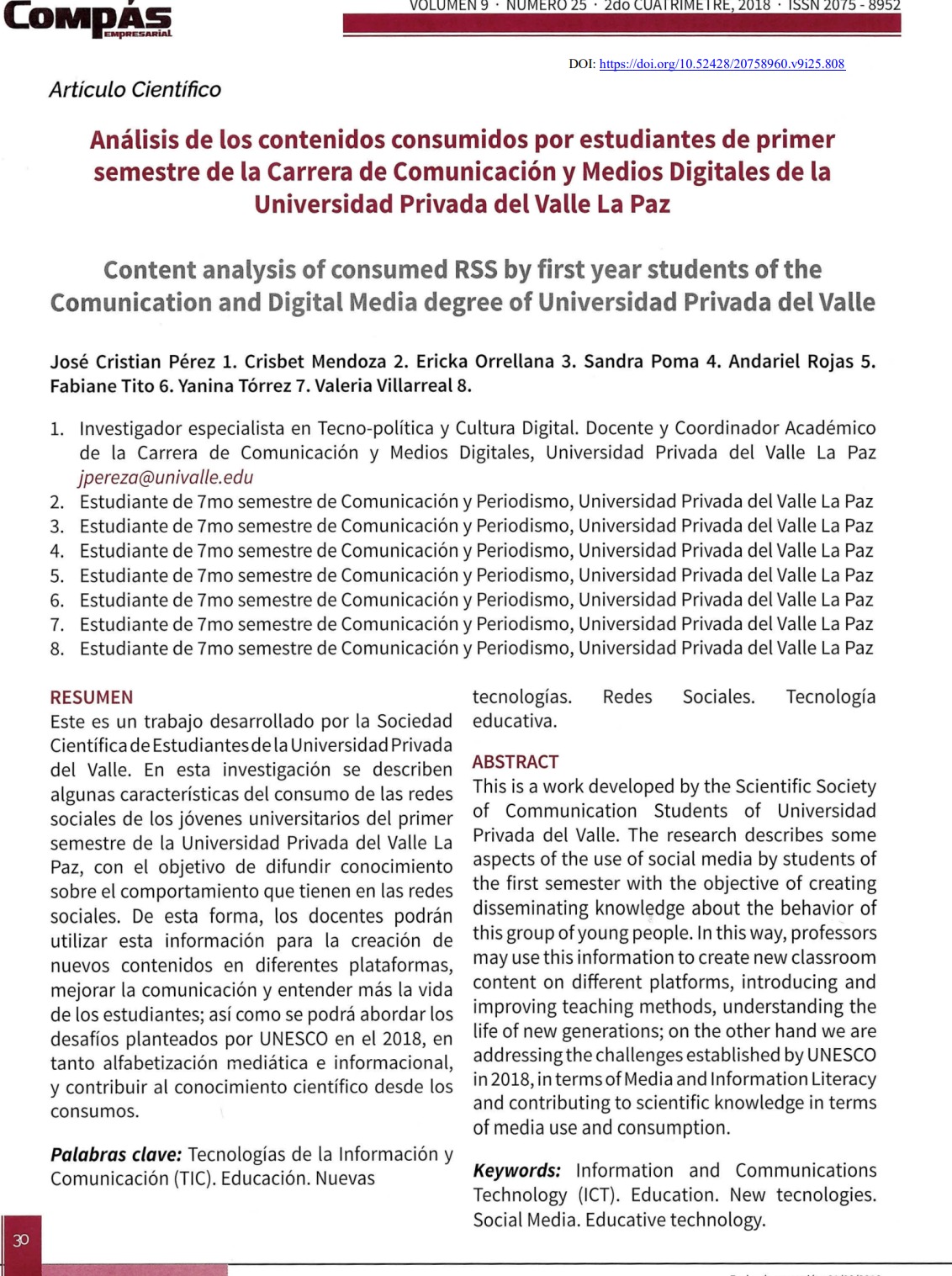Content Analysis of Consumed RSS by First Year Students of the Comunication and Digital Media Degree of Universidad Privada del Valle
DOI:
https://doi.org/10.52428/20758960.v9i25.808Keywords:
lnformation and Communications Technology (ICT), Education, New tecnologies, Social Media, Educative technologyAbstract
This is a work developed by the Scientific Society of Communication Students of Universidad Privada del Valle. The research describes sorne aspects of the use of social media by students of the first semester with the objective of creating disseminating knowledge about the behavior of this group of young people. In this way, professors may use this information to create new classroom content on different platforms, introducing and improving teaching methods, understanding the life of new generations; on the other hand we are addressingthe challenges established by UNESCO in 2018, in termsof Media and lnformation Literacy and contributing to scientific knowledge in terms of media use and consumption.
Downloads
References
(1) Arratia, O., Uberhuaga P., y García, M. (2006). Jóvenes.com: Internet en los barrios populares de Cochabamba. Cochabamba, Bolivia: Fundación PIEB.
(2) Guaygua, G., Riveras, Á. y Quisbert, M. (2000). Ser joven en El Alto. Rupturas y continuidades en la tradición cultural. La Paz: Fundación PIEB.
(3) Horkheimer, M. y Adorno, T. (1988). La industria cultural. Iluminismo como mistificación de masas en Dialéctica Del Iluminismo. Buenos Aires: Sudamericana. p.1-26.
(4) Hug, T. (2013). Competencia mediática y alfabetización visual. Hacia consideraciones más allá de las alfabetizaciones. Consultado el 29 de junio de 2018. México: Razón y Palabra. Recuperado de: http://www.razonypalabra.org.mx/N/N82/V82/26HugV82.pdf
(5) Marín, V. (2006). Medios de comunicación, educación y realidad. Revista Científica de Comunicación y Educación. Huelva, España. p.193-197.
(6) Martín-Barbero, J. (1987). De los medios a las mediaciones: Comunicación, cultura y hegemonía. México D.F.: Gustavo Gili S.A.
(7) Quiroz, E. (2016). Bolivia Digital. 15 miradas acerca de Internet y sociedad en Bolivia. La Paz: Centro de Investigaciones Sociales (CIS).
(8) Ramírez, A. y Ariza, V. (2013). Redes sociales y marcas: hábitos de consumo por internet. Consultado el 29 de junio de 2018. Colombia: Universidad ICESI. Recuperado de: https://repository.icesi.edu.co/bibliotecadigitaI/handle/10906/76578
(9) Reguillo,R. (1994). Reseña de "Elconsumocu ltu ralen México" deNéstorGarcíaCanclini. Consultado el 29 de junio de 2018. México: Sistema de Información Científica Redalyc. Recuperado de: http://redalyc.org/articulo.oa?id=3l66l816
(10) Reguillo, R. (2011). Culturas juveniles: Formas políticas del desencanto. México D.F.: Siglo XXI.
(11) Simonato, F. y Mori, M. (2015). Los Millenials y las redes sociales. Consultado el 29 de junio de 2018. Argentina: Revista Ciencias Administrativas. Recuperado de: http://sedici.unIp.edu.ar/bitstream/handle/10915/46539/documentocompleto.pdf?seguence=4

Downloads
Published
How to Cite
Issue
Section
License
Copyright (c) 2018 José Cristian Pérez

This work is licensed under a Creative Commons Attribution 4.0 International License.
Authors who publish with this journal agree to the following terms:
- Authors retain copyright and grant the journal right of first publication with the work simultaneously licensed under a Creative Commons Attribution License 4.0 that allows others to share the work with an acknowledgement of the work's authorship and initial publication in this journal.
- Authors are able to enter into separate, additional contractual arrangements for the non-exclusive distribution of the journal's published version of the work (e.g., post it to an institutional repository or publish it in a book), with an acknowledgement of its initial publication in this journal.
- Authors are permitted and encouraged to post their work online (e.g., in institutional repositories or on their website) prior to and during the submission process, as it can lead to productive exchanges, as well as earlier and greater citation of published work.









